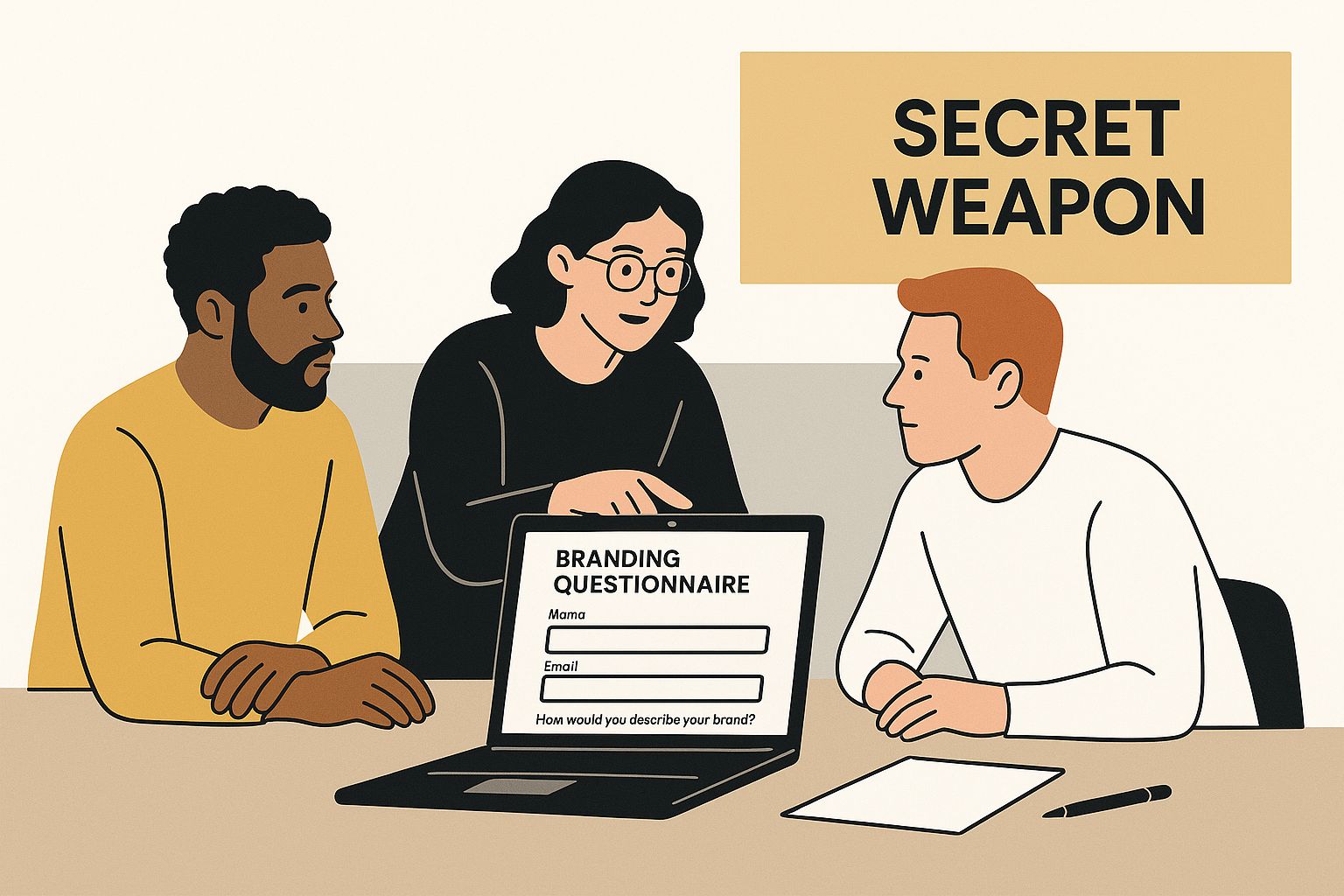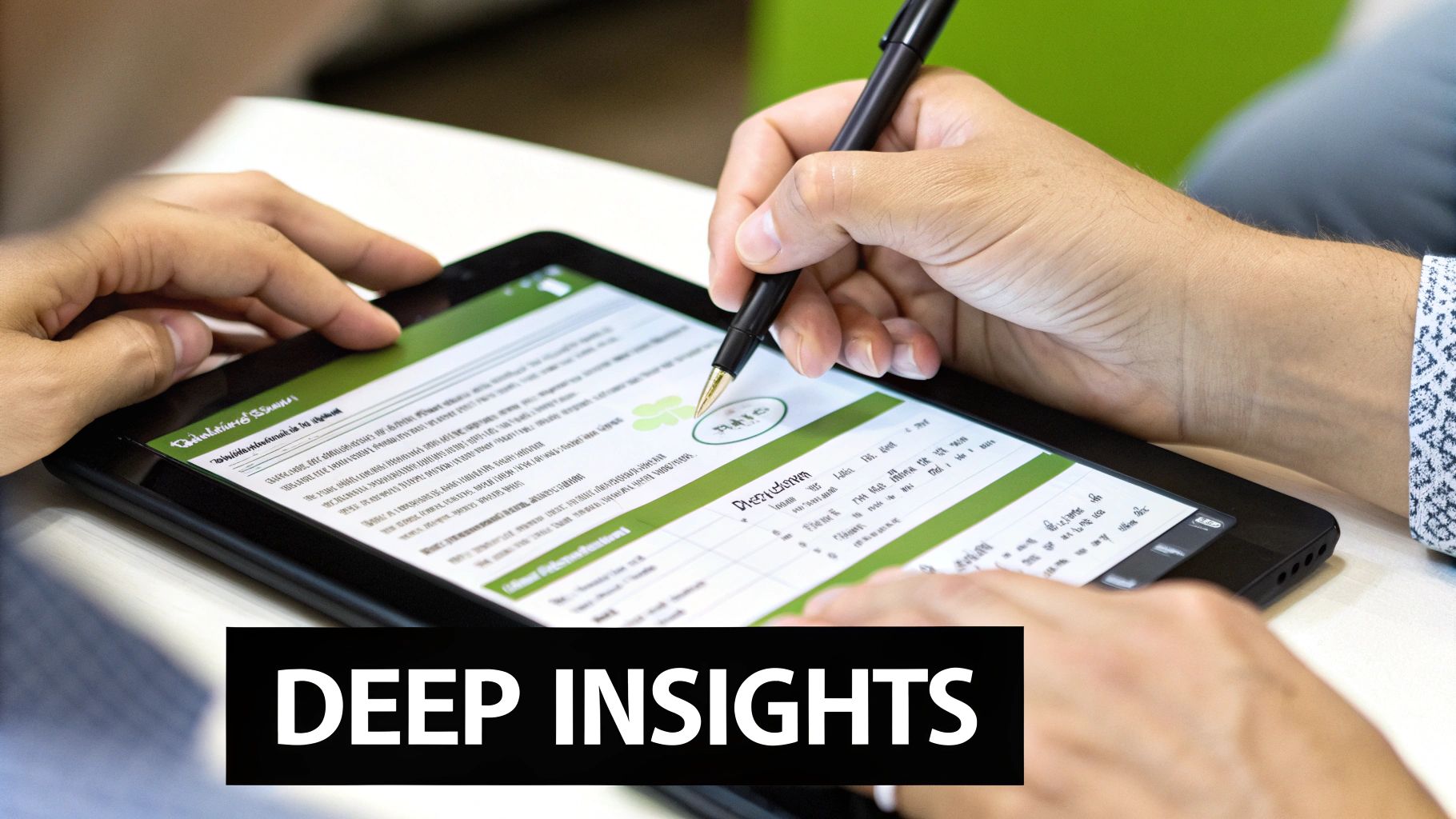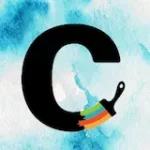A solid branding questionnaire is so much more than a box-ticking exercise; it’s the strategic bedrock for every single decision you’ll make on a project. Using a branding questionnaire template is the fastest way to nail this discovery process, making sure you pull out the essential insights needed to build a brand that people actually connect with.
Why a Great Questionnaire Is Your Secret Weapon
Let’s be real. Kicking off a branding project without a deep dive into the client's world is like trying to navigate a new city without a map. It’s just not going to end well. A well-thought-out questionnaire is your compass, guiding every design choice, every piece of copy, and every strategic move.
Honestly, it's the single best tool for getting everyone on the same page and avoiding the classic project-killers we’ve all experienced—think endless revisions and creeping scope. It helps you uncover the critical details that clients often don't even realize they need to share. You get to push past the surface-level "we need a new logo" and get right to the heart of their business: their vision, their customers' biggest headaches, and what makes them different in a crowded market.
This infographic breaks down how a detailed questionnaire really serves as the foundation for the entire brand development process.

As you can see, it’s not just another form to fill out. It's a critical diagnostic tool that informs every creative step that follows.
The Real-World Impact on Projects
Picture this. Project A starts with a comprehensive discovery questionnaire. The designer gets rich, detailed answers about the target audience, the competition, and the company's five-year plan. They truly get the "why" behind the business. The result? A brand identity that hits the mark on the first try, leading to happy high-fives and a thrilled client.
Now, consider Project B. This one jumps straight into design after a quick phone call. The first concepts are a total miss because the designer had zero context about the client’s actual market position. What follows is a painful cycle of frustration, wasted hours, and a final product that feels generic and uninspired. The difference is night and day, and it all boils down to the quality of that initial discovery phase.
A branding questionnaire isn't just about collecting data; it's about building a shared vision. It elevates you from a simple designer to a strategic partner who’s genuinely invested in the client's success.
Getting this foundational step right is what makes everything else click, especially when it comes time to figure out how to build brand awareness that actually works from the ground up.
More Than Just a Form
Think of a good branding questionnaire template as your diagnostic tool. It lets you "diagnose" a brand's health and potential long before you open a single design file.
This process helps you separate the visuals from the core strategy—a super important distinction you can read more about in our guide on branding vs. logo design. It forces everyone to get crystal clear on the goals and ensures every creative asset you produce is tied to a strategic purpose, not just pretty aesthetics. By putting in the work upfront, you save yourself—and your client—countless hours down the road and deliver work that actually moves the needle.
How to Choose the Right Template for Your Needs
Let’s be honest: not every branding questionnaire template is a winner. Picking one that doesn’t line up with your project’s real scope is like using a sledgehammer to crack a nut—it’s total overkill and you’ll probably just make a mess. The real trick is finding a template that's detailed enough to be genuinely helpful but flexible enough to bend to your specific situation.
Think about it. A scrappy startup trying to find its voice has completely different needs than a massive corporation going through a rebrand. The startup’s questionnaire will dig deep into the basics—mission, vision, ideal customer. On the other hand, the established company’s template needs to tackle brand legacy, current market perception, and how to protect brand equity during the transition.
Your goal is to get way beyond those generic, one-size-fits-all forms. Using a solid questionnaire has become a non-negotiable step for a reason. As of 2025, there are over 10,000 branding agencies across the globe using custom questionnaires in their discovery process. You can find more great insights on building powerful brands over at Kantar.com.
Where to Find Your Starting Point
Sourcing a template is the first step, but where you get it from matters. Different sources offer wildly different levels of quality and customization. Here’s a quick rundown of the usual suspects.
Comparison of Branding Questionnaire Template Sources
| Template Source | Common Features | Pros | Cons |
|---|---|---|---|
| Free Online Resources | Basic sections (mission, audience, competitors). Often in PDF or Google Doc format. | No cost, easily accessible. | Often too generic, may lack depth, requires heavy customization. |
| Creative Marketplaces | Professionally designed, comprehensive sections, multiple formats (InDesign, Word). | High-quality, well-structured, saves time. | Incurs a cost, might include sections you don't need. |
| Agency Blogs/Websites | Industry-specific questions, expert insights baked in. | Based on real-world experience, often very thorough. | May be tailored to the agency's specific process, could require adaptation. |
| DIY (From Scratch) | Completely customized to your process and client type. | Perfectly aligned with your needs, unique to your brand. | Time-consuming to create, risk of missing key questions initially. |
Ultimately, the best source depends on your budget, timeline, and how much work you want to put in. I usually recommend starting with a high-quality paid template and then customizing it—it’s the best of both worlds.
Evaluating Your Template Options
Before you download and run with a template, give it a quick once-over. A great template should feel like a solid starting point, not a restrictive cage. Think of it less like a rigid script and more like a conversation guide that keeps you from missing the important stuff.
Here’s a practical checklist to run through:
- Audience Deep Dive: Does it actually get into the weeds? You want questions that poke at the audience's pain points, dreams, and what their day-to-day life looks like. Basic demographics are just table stakes.
- Competitive Landscape: Does it have specific prompts to map out direct and indirect competitors? A good template encourages a real analysis of their strengths, weaknesses, and where they sit in the market.
- Brand Voice and Personality: It absolutely must have questions that help define the brand’s character. Look for creative prompts like, "If your brand were a person, who would it be?" or word association games.
- Vision and Goals: A solid template will always ask about the long-term business goals. This is critical for making sure the brand identity you build supports where the company is going, not just where it is today.
Remember, the best branding questionnaire template is one that sparks deeper conversations. It’s designed to pull out the "why" behind the business, not just the "what."
Flexibility Is Non-Negotiable
Here’s the thing: no single template will ever be a perfect fit right out of the box. The true test of a good one is how easy it is to adapt.
Can you easily add, remove, or tweak questions to fit a particular client? A rigid structure that locks you in is a recipe for a bland, uninspired outcome.
For example, if you're working with a B2B tech company, you’ll definitely need to add questions about their sales cycle, what makes their tech different, and the jargon their industry uses. Those details are just as crucial as picking a color palette. The whole discovery process is really about gathering intel to build a bigger picture, which is why a good questionnaire lays the perfect foundation for a powerful marketing brief template.
In the end, choosing the right branding questionnaire template is about finding a tool that helps you ask better questions and uncover the real, authentic story at the heart of the brand.
Customizing Questions to Uncover Deeper Insights
A generic branding questionnaire template is a fantastic starting point, but it's never the finish line. The real magic happens when you transform that template into a sharp, strategic tool—one designed to pull out the kinds of insights clients rarely volunteer on their own.
This is how you move from just collecting data to truly understanding a business from the inside out.

The secret is to build your custom questions around the core pillars of brand strategy. When you do this, you guarantee a complete picture of the business, its customers, and where it's headed.
Diving Deep into the Audience
Most templates ask the basics, like age and gender. While that's useful, it barely scratches the surface. To build a brand that actually connects with people, you have to get into their heads and understand what drives them.
So instead of asking, "Who is your target audience?" try pushing for more:
- What specific problem are you solving for your ideal customer? Describe their "before" and "after."
- Walk me through a typical day in their life. What are their biggest frustrations and their biggest dreams?
- If your ideal customer were describing your brand to a friend, what exact words would you want them to use?
Questions like these force your client to think with empathy, giving you the rich, emotional context needed to shape the brand's personality and voice.
Defining the Unique Offer
Every business owner thinks their product is special. Your job is to dig for the why beyond surface-level claims. A generic question like "What makes you different?" almost always gets a vague answer like "we have great customer service."
You have to push for specifics.
A customized questionnaire forces clarity. It helps both you and the client articulate the brand's true value in a way that generic questions simply can't.
Try these more probing questions to get to the heart of what they offer:
- If you had to kill one feature from your product or service, what would it be and why?
- What's the one thing your competitors do that you absolutely refuse to do on principle?
- Besides making money, what’s the core mission that gets your team fired up every single day?
This line of questioning helps distill a brand's unique selling proposition down to its most potent form. This is a non-negotiable step for crafting a strong brand identity and a foundational part of learning how to write a design brief that actually leads to incredible work.
Mapping the Competitive Landscape
Understanding the competition isn't about making a list of names. It’s about finding the gaps in the market—the "white space" your client's brand can own. Your questionnaire should guide this strategic thinking.
Here’s how you can reframe your questions about the market:
| Standard Question | More Insightful Question |
|---|---|
| Who are your main competitors? | Who do your customers perceive as your main competitors, even if they're in a totally different industry? |
| What are their strengths? | What is one thing your biggest competitor does so well that it secretly makes you jealous? |
| How are you different? | Where is the "white space" in the market? What is nobody else doing that you could completely own? |
These questions shift the conversation from a simple checklist to a strategic map, helping you position the brand for maximum impact.
Shaping the Brand's Personality and Vision
Finally, your questionnaire needs to explore the brand's soul and its biggest ambitions. This is where you define the voice, the tone, and the long-term goals. As you customize your questions, it's wise to consider the essential questions every business owner should be able to answer to make sure you're covering all the bases.
Move beyond bland prompts to get to the heart of the brand's character:
- Personality: "If your brand walked into a party, what would it be like? Is it the loud life of the party, the thoughtful intellectual in the corner, or the trusted friend everyone gathers around?"
- Vision: "Fast forward five years. What's the one headline you would be ecstatic to see written about your company?"
By customizing your branding questionnaire template this way, you're not just gathering data. You're collecting stories, emotions, and a clear vision. That's the raw material you need to build a brand that isn't just beautiful, but one that is meaningful and wildly effective.
Embedding Legal and Trademark Questions Early
Let's be honest, a killer brand identity that you can't actually own legally is a ticking time bomb. It’s a classic mistake: everyone gets wrapped up in the creative vision, only to hit a massive legal roadblock months down the line. That's precisely why your branding questionnaire template needs to tackle intellectual property right from the jump.
This isn't about killing the mood or being a pessimist. It's about being a sharp, strategic partner. By asking about naming ideas, domain availability, and potential trademark conflicts early on, you steer your client toward a brand that’s not just stunning, but legally sound and built to last.
Avoiding Future Legal Headaches
Picture this: you've poured weeks into a brilliant brand identity. The client is thrilled. Then, they discover their chosen name is already trademarked by a competitor. It’s a costly, soul-crushing setback that sends everyone back to the drawing board. You can sidestep this whole disaster by building these questions into your initial discovery phase, flagging issues before they snowball into expensive problems.
And the landscape is crowded. To give you an idea, in 2023, there were roughly 88.2 million active trademarks registered around the world. On top of that, trademark offices received 15.2 million new applications that year alone. You’re not just looking for a cool name; you're looking for an available one.
Essential Questions to Include
You don’t have to be a lawyer to ask smart, preliminary questions. The goal here is just to get the client thinking about the legal side of things and nudge them to do their own due diligence.
Here are a few must-haves for your template:
- Name & Domain Check: "Have you searched to see if your top three business name ideas are available as domain names (.com, .co, etc.) and on the social media platforms you care about?"
- Trademark Searches: "Have you done a quick, preliminary search on the USPTO database (or your country's version) for your proposed business name or taglines?"
- Existing Conflicts: "Are you aware of any other companies in your space using a similar name, logo, or slogan that might cause confusion?"
Think of these questions as an early warning system. They kickstart important conversations and make sure legal checks are part of the process from day one, not a frantic afterthought.
Baking this legal foresight into your process also strengthens your client relationships. It shows you’re a thorough professional who’s got their back. It's a good idea to mention this step in your project scope, which can be detailed in your formal contract. For more on that, take a look at our guide on putting together a solid graphic design agreement. It’s a simple step that protects both of you and paves the way for a smooth, successful project.
How to Present the Questionnaire and Analyze the Answers
The questions you ask are only half the battle. How you deliver your branding questionnaire and what you do with the answers—that’s what turns raw data into a brilliant creative strategy. Your presentation method really sets the tone for the entire project.

Sure, you could just email over a Word doc. But think about a more collaborative approach. Hosting a live workshop to walk through the questions together can unearth insights that written answers just can't capture. It transforms a simple form into a dynamic conversation, letting you ask follow-up questions on the spot and dig deeper.
If a workshop isn’t in the cards, an interactive digital form is the next best thing. Platforms like Typeform or Google Forms make the process more engaging for your client and way easier for you to collect the data. Whatever method you choose, always be upfront about the time commitment and why their thoughtful responses are so crucial.
Synthesizing the Raw Data
Once the client hits "submit," the real work begins. Your first move should be to read through every single answer without any judgment. Just absorb the information. You're trying to see past individual answers to spot the bigger picture.
I like to create a synthesis document to cluster related ideas together. Keep an eye out for recurring words, phrases, and concepts.
- Core Themes: What are the top three ideas that keep popping up? Maybe it’s about their audience's pain points, their company culture, or their unique value prop.
- Brand Voice Clues: Pay close attention to the language the client uses. Is it formal and corporate? Or playful and witty? This is your first real clue to the brand personality they're aiming for.
- Contradictions: Make a note of any answers that seem to conflict. For example, they might say they want a "modern and edgy" brand but then list very traditional companies as their inspiration. These are goldmines for follow-up conversations.
This process is a lot like the qualitative analysis you’d use when you conduct user research. You're hunting for patterns in subjective data.
Turning Words into an Actionable Roadmap
With your themes identified, it’s time to translate everything into a tight, actionable brief. This document becomes the north star for the project, guiding every design and copy decision from here on out. It’s also where you connect their answers to what's happening in the broader market.
Your analysis should bridge the gap between what the client said and what your creative team needs to do. This translation is where your strategic value truly shines.
Understanding consumer trust, for instance, is massive right now. For 71% of global consumers, trust has become a 'buy or boycott' issue. It’s a huge theme to explore in any brand analysis. If a client’s answers consistently circle back to reliability and expertise, your creative brief needs to state that building trust is a primary design objective.
Your final output should be a concise summary that distills pages of answers into a clear set of directives. This gets everyone on the same page before a single pixel is pushed, turning client words into a clear roadmap for success.
Got Questions? Let's Talk Strategy.
Even with the best branding questionnaire in hand, things can get… interesting. It’s all part of the process. Knowing how to navigate the common bumps in the road is what separates the pros from the rookies. Let's dig into a couple of the most common situations that pop up during brand discovery.
What if the Client Gives Super Short Answers?
Ah, the classic one-word wonder. You pour your heart into crafting the perfect questionnaire, and you get back answers that give you almost nothing to go on. Don’t sweat it. This is rarely a sign of a bad client; it usually just means they're busy, overwhelmed, or just not great at putting their thoughts into words.
This is your cue to switch gears.
Instead of feeling stuck, treat their short answers as breadcrumbs. Schedule a follow-up call and frame it as a quick jam session to "dig a little deeper" into their ideas.
For instance, if their answer to "Who is your target audience?" is just "small businesses," you can jump in with questions like:
- "Awesome, that's a great starting point. When you picture your ideal customer, what does their day-to-day look like?"
- "What's the one big, frustrating problem you're solving for them that keeps them up at night?"
- "And just so we're on the same page, is a 'small business' a one-person shop or a team of 20?"
See what happens? You’ve just turned a potential roadblock into a chance to connect and show you're a strategic partner, not just an order-taker.
Your real job is to be a guide. If the written questionnaire hits a wall, pivot to a live conversation. That's often where the real magic happens.
When Should I Ditch the Questionnaire for a Workshop?
A branding questionnaire template is a powerful tool, but it's not a silver bullet. Sometimes, a live workshop is just plain better. This is especially true when you’ve got a lot of cooks in the kitchen—think a whole founding team or a marketing department with multiple decision-makers.
Honestly, trying to herd five different executives to fill out a form and then attempting to stitch their conflicting answers together is a straight-up nightmare. A facilitated workshop gets everyone in the same room (virtual or otherwise) to hash things out and build consensus right then and there.
Workshops are also the way to go for really complex projects or for clients who just aren't writers. You can feel the energy in a live session—it sparks ideas and uncovers insights a static Google Doc never could.
Here at Creativize, we live for this stuff. We connect businesses with brilliant creative pros who know exactly how to ask the right questions to build brands people love. Ready to find your perfect match? Start your search at https://creativize.net.

